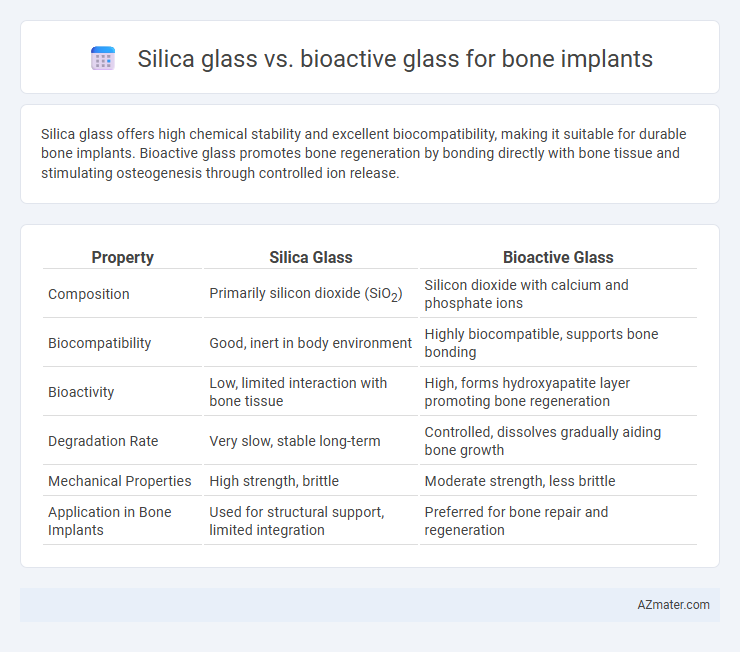Silica glass offers high chemical stability and excellent biocompatibility, making it suitable for durable bone implants. Bioactive glass promotes bone regeneration by bonding directly with bone tissue and stimulating osteogenesis through controlled ion release.
Table of Comparison
| Property | Silica Glass | Bioactive Glass |
|---|---|---|
| Composition | Primarily silicon dioxide (SiO2) | Silicon dioxide with calcium and phosphate ions |
| Biocompatibility | Good, inert in body environment | Highly biocompatible, supports bone bonding |
| Bioactivity | Low, limited interaction with bone tissue | High, forms hydroxyapatite layer promoting bone regeneration |
| Degradation Rate | Very slow, stable long-term | Controlled, dissolves gradually aiding bone growth |
| Mechanical Properties | High strength, brittle | Moderate strength, less brittle |
| Application in Bone Implants | Used for structural support, limited integration | Preferred for bone repair and regeneration |
Introduction to Bone Implant Materials
Silica glass and bioactive glass are prominent materials in bone implant applications due to their biocompatibility and osteoconductive properties. Silica glass primarily provides structural support and promotes bone bonding through its stable silicon dioxide matrix, while bioactive glass contains calcium and phosphate ions that actively stimulate bone regeneration and integration. The selection between these materials depends on the desired balance between mechanical strength and bioactivity for effective healing and implant longevity.
Overview of Silica Glass
Silica glass, primarily composed of silicon dioxide (SiO2), is renowned for its high chemical stability, biocompatibility, and mechanical strength, making it a favored material for bone implant applications. Its amorphous structure allows controlled bioinertness, limiting dissolution in physiological environments and providing structural support during bone healing. Unlike bioactive glass, silica glass does not inherently promote bone bonding or regeneration but serves as a durable scaffold suited for load-bearing implants.
Overview of Bioactive Glass
Bioactive glass is a highly biocompatible material characterized by its ability to bond directly with bone tissue, promoting osteointegration and accelerating healing processes. Unlike silica glass, bioactive glass undergoes controlled surface reactions in physiological environments, leading to the formation of hydroxycarbonate apatite, which closely resembles natural bone mineral. Its unique composition, often containing silicon, calcium, sodium, and phosphorus oxides, facilitates cellular responses and bone regeneration, making it a superior choice for bone implant applications.
Biocompatibility of Silica Glass vs Bioactive Glass
Bioactive glass demonstrates superior biocompatibility compared to silica glass due to its ability to form a direct bond with bone tissue through the formation of a hydroxycarbonate apatite layer at the implant site. Silica glass typically exhibits inert behavior with limited biological interaction, while bioactive glass actively stimulates osteogenesis and supports cellular proliferation and differentiation. This enhanced bioactivity makes bioactive glass a preferred material for bone implants, promoting faster integration and improved healing outcomes.
Mechanical Properties Comparison
Silica glass exhibits high hardness and excellent wear resistance but tends to be brittle, limiting its mechanical durability in load-bearing bone implants. Bioactive glass, while possessing lower intrinsic strength than silica glass, offers superior toughness and fracture resistance due to its ability to bond chemically with bone tissue, enhancing implant stability. The balance between silica glass's rigidity and bioactive glass's biointegration results in differing performances, with bioactive glass often preferred for implants requiring long-term mechanical compatibility and biological interaction.
Osseointegration Capabilities
Bioactive glass demonstrates superior osseointegration capabilities compared to silica glass due to its ability to form a strong chemical bond with bone tissue by releasing biologically active ions that stimulate osteoblast activity and bone regeneration. Silica glass primarily acts as an inert scaffold, providing mechanical support but lacking the bioactivity necessary to promote rapid bone integration. The ion exchange and surface bioactivity of bioactive glass facilitate enhanced bone bonding and remodeling, making it more effective for bone implant applications.
Bioactivity and Bone Bonding
Bioactive glass exhibits superior bioactivity compared to silica glass, promoting rapid formation of hydroxycarbonate apatite (HCA) layer that closely mimics natural bone mineral. This enhanced bioactivity facilitates strong chemical bonding with bone tissue, improving osseointegration and accelerating the healing process. In contrast, silica glass demonstrates limited bone bonding capabilities due to its lower reactivity and slower apatite layer formation.
Long-term Performance in Bone Implants
Silica glass exhibits excellent chemical durability and mechanical stability, making it suitable for long-term bone implant applications, but its bioinert nature may limit direct bone bonding. Bioactive glass, enriched with calcium and phosphate ions, actively promotes osteointegration and stimulates new bone growth, ensuring superior long-term biological performance. Studies show bioactive glass implants maintain structural integrity while enhancing bone regeneration, leading to improved implant lifespan and reduced failure rates compared to traditional silica glass.
Clinical Applications and Case Studies
Silica glass shows strong osteoconductive properties and has been widely used in load-bearing bone implants, with numerous case studies demonstrating effective integration and mechanical stability in long-term clinical applications. Bioactive glass, composed primarily of calcium, sodium, and phosphate ions, exhibits exceptional bioactivity by stimulating bone regeneration and forming a strong chemical bond with bone tissue, which is supported by clinical trials highlighting accelerated healing in critical-size bone defects. Comparative studies reveal bioactive glass outperforms silica glass in promoting faster osteogenesis and reducing implant rejection rates, making it a preferred material in reconstructive surgery and orthopedic applications.
Future Prospects and Developments
Silica glass and bioactive glass both hold significant promise for bone implant applications, with bioactive glass showing superior osteoconductivity and the ability to stimulate bone regeneration due to its ionic dissolution products. Future developments in bioactive glass focus on enhancing its mechanical strength and tailoring its degradation rates to match bone healing processes, while silica glass research aims to improve biocompatibility and fracture resistance through nanostructuring and doping with biologically active ions. Emerging technologies such as 3D printing and composite materials are expected to advance the integration and functionality of these glass types in personalized bone implants, fostering improved clinical outcomes.

Infographic: Silica glass vs Bioactive glass for Bone implant
 azmater.com
azmater.com